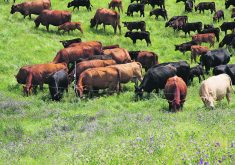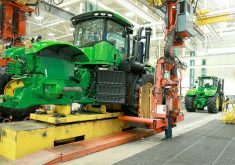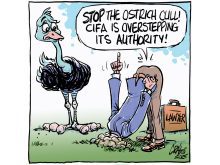Don’t sacrifice
The Premiers of the four western provinces recently issued a joint News release
news calling on the federal government to increase cuts to over-quota import tariffs on “sensitive products” such as dairy.
These import tariffs are instrumental in maintaining supply-management programs in the dairy and poultry sectors in Canada. If the Western Premiers actually get what they’re asking for, they will be responsible for killing the only sector of agriculture that’s currently making money, is not reliant on taxpayers for ad hoc payments, and is benefiting consumers.
Read Also

Budget seen as fairly solid, but worrying cracks appear
The reaction from the agriculture industry to prime minister Mark Carney’s first budget handed down November 4th has been largely positive.
… Canadian governments have always been eager to trade something that was working for farmers in exchange for a promise of more market access. We shouldn’t be surprised that the European Union and the United States do not use this type of negotiating tactic.
The two-price system for wheat was scrapped in the 1980s to appease the U.S. at the beginning of the Free Trade Agreement. The Crow transportation payments were scrapped to give us the benefits of NAFTA (North American Free Trade Agreement) and the WTO (World Trade Agreement).
The Alberta government, in particular, has been instrumental in sacrificing programs or provisions at the same time as it is spending millions of dollars annually to undermine the Canadian Wheat Board (CWB). The CWB, according to a recent study, returns an estimated $800 million more every year into farmers’ pockets than the Chicago exchange would have.
While the Premiers claim the cuts to over-quota import tariffs are necessary in order to increase “market access” for other commodities, there are no guarantees other countries will open their borders to more Canadian grains, oilseeds and livestock. What is certain, however, is that we will be sacrificing a stable, profitable Canadian market for an unstable, low-return market. Twenty years of increasing agricultural exports has not translated into higher net farm incomes. In fact, exports have never been higher while realized net incomes have never been lower.
It’s not lack of farmers’ market access that’s the problem. It’s lack of farmers’ market power.
Over the last two decades, federal and provincial farm policies have fostered increased exports for lower prices at the farmgate. Market access has been accomplished by sacrificing policies that provide farmers some power in a marketplace that is increasingly dominated by fewer and larger players. Why are western Canadian governments so eager to continue this trend? Why are they continuing on a path of producing high volumes of commodities for prices that are unsustainable for farmers?
Why? Because there is a silver lining on the other side of the equation: while net farm income levels were at record lows last year, agribusiness corporations that sell us inputs, or process and trade agricultural commodities, reported record or near-record profits in that same year. These corporations … continue to inundate the political spheres in Edmonton, Regina, Winnipeg and Ottawa with a swarm of paid lobbyists and bags of campaign donations.
Giving away the tools to have sustainable production in dairy and poultry is not going to benefit grain and oilseeds producers in Canada. What it will do, though, is pad the already-hefty profits of Cargill, ADM, Tyson, Nestle, Saputo, Unilever, Parmalat, Safeway and Superstore. Ultimately, Canadian consumers will pay more for dairy and poultry that is shipped up here from heavily subsidized industrial mega-farms, run on cheap Mexican labour south of the border.
– Jan Slomp,
Alberta Co-ordinator,
National Farmers Union,
Rimbey, Alta.
Photo says a lot
Congratulations to Western Producer columnist Ed White for the award-winning photos used in his article “Hog plant still on track” (WP June 1/06, p.10).
Together, these two photos capture much of what is wrong with the obsessive expansion of the hog industry across this country: a broken system in a broken society.
The photo of the proponents of the OlyWest slaughterhouse, comfortably seated in the public gallery of Winnipeg’s City Hall, symbolizes the greed, as if we were dumb and blind, which drives the hog industry and which continues to exploit our water, our health, our tax dollars, the neighbourhoods, the workers, and, unspeakably, the animals.
For what? To keep the fat wallets in the slaughterhouse board rooms happy.
In stark and horrible contrast, the photo of the opponents of this project, standing, as they watch City Hall proceedings through bars (in this democratic and civilized country), symbolizes the relentless struggle of thousands of citizens, using common sense and sanity, who are trying to protect our water, our health, our communities, the workers and the animals confined in the pig factories.
For what?
So that their children, and their children’s children, might live in thriving communities with clean air, soil and water, and where consumers purchase their food from local producers who use humane, sustainable methods to farm.
Hopefully, the grandchildren of the folks involved in this ongoing issue will see these photos, ultimately, they will judge which side truly cared about their future.
– Elaine Hughes,
Archerwill, Sask.
Emission worry
The (Western) Producer of 25 May 2006 carried a first page item titled: “Gas emissions not significant to cattle health” that may be somewhat misleading in some respects.
About four years ago author Andrew Nikiforuk received the Governor General’s award for the best Canadian non-fiction book of the year for his Saboteurs: Wiebo Ludwig’s War Against Big Oil. For years Ludwig had contended that some of his family members and some of his livestock were adversely affected by emissions and/or “flaring” in the vicinity of his farm (in the Grande Prairie region). In the following February Nikiforuk, during a CBC interview, stated that a just released Alberta government report related to human health had found that the incidence of human respiratory problems in the Grande Prairie region was two or more times higher than the average for the province of Alberta. At that time the Grande Prairie region had the most intense energy industry activity in Alberta.
Ludwig lost his war against “pollution from Big Oil.” He went to jail for damaging some energy industry sites or equipment. Big Oil won.
I live in Edmonton and sometimes I walk the half-mile between 62 Avenue and 51 Avenue on the west side of 122 Street. The sidewalk is about three metres from a page wire fence which separates the street and sidewalk from a University of Alberta field for crop research. A year or so ago I observed that there is some slight, but variable, rusting of parts of the page wire fence. On closer casual appraisal of the fence I saw that where there was dense growth of trees beside the fence, or where grass and weeds were about half a metre high there was less rusting of the fence.
So what is causing the differences in effects on the page wire fence? I speculate that emissions from the several coal-fired electric power-generating plants may be causing the slight rusting. The trees and grass (where applicable) may be protecting the fence from power plant emissions. Alternatively the trees and grass may be obtaining sulfur, an essential plant nutrient, thereby reducing the amount of fence corroding atmospheric sulfur.
The foregoing speculation has in part been inspired by what is transpiring at the University of Alberta’s renowned Breton Plots. In 1960 a cairn was erected to honour three decades of remarkable research at the plots. … The cairn, about 1.5 meters by 1.7 meters, is made of stones collected nearby and held together by a cement grout. In the recent half dozen years there has been increasing deterioration of the cement grouting. But the deterioration is more definite on the north and west sides of the cairn.
How so? Why so?
… the wind in that region comes primarily from the north/northwest. The coal-fired electric generating plants referred to (previously) are large and numerous, to the north and northwest of the Breton Plots. Atmospheric sulfur may have contributed to some bewildering, as yet not proven causes of puzzling crop yield changes on some of the plots.
In my opinion, the world, and especially Canada, and especially, especially Alberta, are failing to halt or reduce deterioration of the environment on which we all depend.
– C. F. Bentley, P. Ag.,
Edmonton, Alta.














